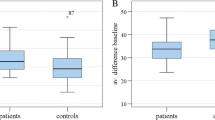Abstract
· Background: Advanced glaucoma typically results in damage of the temporal neuroretinal rim. As vascular factors are of pathogenic importance in the development of glaucomatous damage, the present study investigated whether regional differences in perfusion might be the reason for the preferential damage of the temporal neuroretinal rim. · Material and methods: Blood flow of the neuroretinal rim was measured with the laser Doppler flowmeter (LDF) Oculix 4000 (continuous measurement of an area of 160 µm diameter) and the Heidelberg retina flowmeter (HRF). Both instruments measure the capillary blood flow (flow), the relative velocity of erythrocytes (velocity) and the relative volume of moving erythrocytes (volume). We examined one randomly chosen eye of 55 healthy subjects without history of glaucoma aged 22–57 years (mean 30 years). Each subject was measured with the LDF and HRF, each time nasally and temporally, away from visible vessels. The intraocular pressure (IOP) was measured with the Goldmann tonometer. Heart rate and systolic and diastolic blood pressure were measured. · Results: The LDF measurements of the optic nerve head showed nasal flow of 12.4±5.6 AU and temporal flow of 9.8±3.6 AU. The HRF showed a nasal flow of 477±161 AU and a temporal flow of 368±166 AU. The volume measurements done by LDF showed nasally a value of 0.68±0.40 AU and temporally a value of 0.46±0.21 AU. The HRF volume measurements showed nasal values of 16.1±4.3 AU and temporal values of 13.0±4.0 AU. The LDF velocity values were nasally 0.22±0.05 kHz and temporally 0.26±0.05 kHz. HRF measurements showed velocity values of 1.7±0.5 kHz nasally and 1.3±0.6 kHz temporally. The differences were highly statistically significant for flow (LDF P=0.00007, HRF P=0.0005), volume (LDF P=0.00002, HRF P=0.00004) and velocity (LDF P=0.0002, HRF P=0.00004). The IOP was 12.6 mmHg. Blood pressure was 118/75 mmHg and the heart rate was 73 beats per minute. There was no correlation between age, IOP, BP and HR and the HRF/LDF measurements. · Conclusion: The measurements with two different methodologies showed a decreased blood flow of the temporal neuroretinal rim compared to the nasal side. These local differences might be one reason for the preferential damage of the temporal neuroretinal rim in advanced glaucoma.
Similar content being viewed by others
Author information
Authors and Affiliations
Additional information
Received: 16 February 1998 Revised version received: 17 August 1998 Accepted: 21 September 1998
Rights and permissions
About this article
Cite this article
Boehm, A., Pillunat, L., Koeller, U. et al. Regional distribution of optic nerve head blood flow. Graefe's Arch Clin Exp Ophthalmol 237, 484–488 (1999). https://doi.org/10.1007/s004170050266
Issue Date:
DOI: https://doi.org/10.1007/s004170050266




